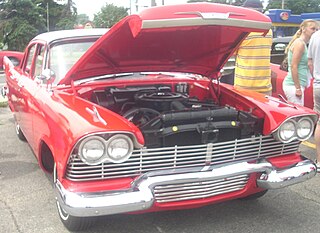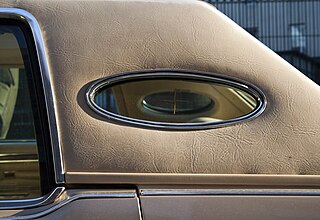
The Dodge Rampage was a subcompact, unibody coupe utility based on Chrysler's L platform and manufactured from 1982 to 1984. First released as a 1982 model, the Rampage was later joined for 1983 by its rebadged variant, the Plymouth Scamp.

The Plymouth Barracuda is a two-door automobile manufactured by Plymouth from 1964 to 1974.

The Plymouth Caravelle is a mid-size sedan that was introduced by Plymouth as a 1983 Canadian model. The Caravelle came to the United States in 1985 to replace the Chrysler E-Class. It was essentially identical to the concurrent Dodge 600. It was replaced by the Plymouth Acclaim in 1989. The Caravelle was Plymouth's first front wheel drive mid-size sedan.

The Dodge Colt were subcompact cars manufactured by Mitsubishi Motors and marketed by Dodge for model years 1971-1994 as captive imports. Badge engineered variants included the Plymouth Champ and Plymouth Colt, marketed by Plymouth.

The Plymouth Laser is a sports coupe sold by Plymouth from 1989 to 1994. The Laser and its siblings: the Mitsubishi Eclipse and Eagle Talon, were the first vehicles produced under the newly formed Diamond Star Motors, a joint-venture between the Chrysler Corporation and the Mitsubishi Motors Corporation. The "Laser" name was recycled from an earlier sports coupe sold as the Chrysler Laser during the 1980s.

The Dodge Stratus is a mid-size car that was introduced by Dodge in February 1995, and was based on the 4-door sedan Chrysler JA platform. The Stratus, Plymouth Breeze, and Chrysler Cirrus were all on Car and Driver magazine's Ten Best list for 1996 and 1997. It received critical acclaim at launch, but ratings fell over time. An updated version of the Stratus was introduced for 2001, with the Cirrus being renamed as the Chrysler Sebring, and a coupé model was also added to the range. However, production ended at the Sterling Heights Assembly Plant in early 2006 which had built 1,308,123 Stratus and Sebrings since 2000. The Dodge Avenger replaced the Stratus nameplate in early 2007 for the 2008 model year.

The Dodge Aspen, which was produced during the 1976 to the 1980 model years, was a compact car, along with its then-concurrent Plymouth branded counterpart, the Volaré, which was launched as a four-door wagon, a four-door sedan and a two-door coupe. By the end of their production run, the Aspen and Volaré would be considered intermediate cars.

The Plymouth Fury is a model of automobile which was produced by Plymouth from 1955 to 1989. It was introduced for the 1956 model year as a sub-series of the Plymouth Belvedere, becoming a separate series one level above the contemporary Belvedere for 1959. The Fury was a full-size car from 1959 to 1961, then a mid-size car from 1962 to 1964, again a full-size car from 1965 to 1974, and again a mid-size car from 1975 to 1978. From 1975 to 1977 the Fury was sold alongside the full-size Plymouth Gran Fury. In 1978, the B-body Fury was the largest Plymouth, and by 1979, there was no large Plymouth. This was rectified in 1980 with the R-body Gran Fury, followed by the M-body Fury in 1982. Production of the last V8, RWD Plymouth Fury ended at Kenosha, WI, on December 23, 1988. Unlike its sibling brand, Dodge, Plymouth would not live to see the resurgence of the large, V8/RWD sedan. The last Plymouth rolled off the Belvedere assembly line in 2001.

The Plymouth Plaza is an automobile which was produced by Plymouth from 1954 through the 1958 model year.

The Plymouth Savoy is an automobile model produced from the 1954 through 1964 model years by Plymouth.

The Dodge Kingsway is an automobile built by Dodge for export markets. The Kingsway name was adopted for the 1946 models. Before that, the export models based on Plymouth models had no unique model names.

The Dodge Polara is an automobile introduced in the United States for the 1960 model year as Dodge's top-of-the-line full-size car; after the introduction of the Dodge Custom 880 in 1962, the Polara nameplate designated a step below the full sized best trimmed Dodge model; the Polara that year had been downsized to what was in effect intermediate, or mid-size status. In its various forms, the Polara name was used by Dodge until 1973, when its position in Dodge's line-up was replaced by the Dodge Monaco. The name Polara is a reference to the Polaris star, in a marketing attempt to appeal to the excitement surrounding the Space Race during the early 1960s. The Polara was a competitor to the Ford Galaxie 500 and the Chevrolet Impala.

The Plymouth Gran Fury is a full-sized automobile that was manufactured by Plymouth from 1975 to 1989. The nameplate would be used on successive downsizings, first in 1980, and again in 1982, through what would originally have been intermediate and compact classes in the early 1970s, all with conventional rear-wheel drive layouts. By the time Chrysler ended M-body production in December 1988, they were Chrysler's last remaining rear-wheel drive cars, with a V8 and carburetor, a configuration used since the mid - 50's. Plymouth would not have another rear-wheel drive car until the 1997 Prowler roadster.

The DeSoto Diplomat is an automobile produced by DeSoto from 1946 to 1962 for sale in export markets other than the United States and Canada.

Opera windows are small, fixed porthole-sized side windows in the C-pillar of some cars. Typically offered in unison with a vinyl roof, opera windows were a very common feature of American automobile design during the 1970s. The design proved to be very popular, indicated by its imitation by almost every domestic manufacturer.

The Plymouth Explorer was a 1954 concept car coupe. It was designed by Luigi Segre at Carrozzeria Ghia.

The Plymouth De Luxe and Special De Luxe were full-sized automobiles which were produced by American manufacturer Plymouth during the 1941-42 and 1946-50 model years.

Eliza Kate Coupe is an American actress and comedian, known for playing Jane Kerkovich-Williams in the ABC comedy series Happy Endings, Denise "Jo" Mahoney in the final two seasons of the medical comedy-drama Scrubs, and her recurring role as Hannah Wyland in Quantico.





















